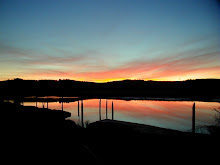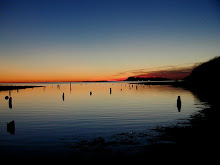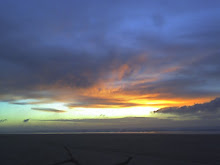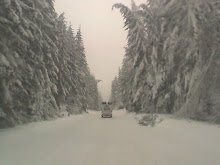Port of Peninsula, Pile Driver and Oyster Picking
Click Twice on the lower left arrow button to start the video.
Dad and I were down at the Nahcotta dock a month ago and here's Bergerson's crawler crane using a crawler crane mounted diesel engine pile driver to set steel piles for the new Port of Peninsula dock. The hammer is essentially a 2-stroke diesel engine in which the piston is also the driving hammer. You can't really see the action within the steel cage held aloft by the crane, but there is a massive single cylinder engine up there and once the crew lights her off, a lot of force is generated and it is quite loud. See this great website for a history on pile drivers http://www.vulcanhammer.info/.
These galvanized steel piles are pounded in what are called "bents" or rows of piles. Then steel i-beams are laid atop the piles and welded in place, subdecking/framing is put on the i-beams and a concrete deck is poured atop.
The piles in the video are at put in at an angle and welded to the verticle piles to stabilize the dock and they are called "brace piles" or "batter piles". The new dock replaces the old wooden dock originally put in about 1958 or so. It was on it's last legs so to speak. The port is home to over a dozen oyster dredges and many of the oysters are transferred over the dock to large trucks. When a truck backed up on the old dock and hit the air brakes, you could feel the dock shudder and sway. Docks are easily destroyed by marine vessels hitting them and here is why. A bigger boat/ship/ferry etc can way many tons and as they glide through the water, they've got a lot of motion behind that weight. This is why when a ferry's electrical switching system fails as the captain asks for full reverse...a ferry dock can be destroyed in a matter of seconds. All that weight in motion meets the dock and crunch goes the dock. This is why docks have massive fender piles and bumper piles to asorb the shock of a ship tenderly bumping it.
The new dock is bigger, stronger, and can accommodate the bigger trucks that haul more oysters that are delivered to the dock by bigger dredges. 40 years ago, nearly all (except the Robert M) dredges were wood. Today..wood dredges are in the minority. Wiegardt's "Leader" and "Tidepoint" are examples of the older wood dredges. "Tide Point" was built in at the Ilwaco Boat Works half a century ago. New dredges are metal and either steel (Hawk's Point) or marine grade aluminum (Northern for example). Just as the dredges evolved..so has the dock.
I worked on the Leader for a bit one summer, shoveling oyster shell off and then picking up tubs. Sam Slagle ran it and we all called it the "Leaner" for its pronounced lean to starboard as I recall. I also had an opportunity to be on the Tidepoint a few times. I recall that Ed Houston was the boat captain at the time and when he retired, Ernie Sadewasser was the boat captain. One time Dave Wiegardt and I were sitting on the top of the wheel house watching Bob Hunt and Allen Ray Allen pick up tubs. Ernie laid on the air horn just for fun and Dave and I just about jumped off the dredge.
Ed Houston was the bed foreman and his picking crew would go out and pick tubs in a line, Ed was very particular about lining up the tubs and carefully coiling the rope and wooden floats on top of full tubs because when the tide came in, the dredge would sidle up to the row of wooden floats floating up from the tubs and began to hoist them one by one and dump them on deck.
A bunch of us kids from the area where also in Scouts and we wanted to go the International Jamboree in Japan in '71. Dobie and Lee Wiegardt agreed to hire us on as oyster pickers so that we could raise money. Of course, we are 15 year old kids out there picking oysters with men in their 30's and 40's who have been picking most their life. Brutal work.
Ed made sure that the working man got the best ground to pick and in a tide I recall that the best pickers could bring in 240 bushels or 10-12 tubs. Us kids could barely do 1/3 of that, around 4 tubs or 80-100 bushels. At 17 cents per bushel that would be $17 U.S. per tide for us and nearly nearly 3 times that for an adult. Very hard work often defined as "assholes and elbows".
One time we were picking and Ed walks over to me and says "I see your dad's coming over". I glance up (not wanting to stand up and look around) and I see this figure about a mile off and I say "how you know it's him?". Ed laughed and said "I've been watching your father walk across the flats for 25 years and I can tell who it is just by his walk".
Once the tide came in, Ed ran the Tidepoint out to the tubs. The headman on deck called the "cowboy" threw a loop of chain into the water and around the floating wooden block. Then the boat captain would instantly winch the tub (which was full of water, mud, oysters) up, and as the tub cleared the bay, water would pour out the side strakes of the tub and he'd swing the tub on deck where the deckhand would attach a metal hook to the bottom of the tub and then the tub would be winched upside down and the oysters dumped out. The boat captain was a busy man running two winches, the main engine, the wheel, and keeping and eye out for the line of tubs.
Picking oysters was and is very hard work and tough on the body. Typically you are wearing heavy hip boots and walking in mud trying to pack a wire bushel basket filled with oysters and dump it in a tub that might be 20-50 feet away from you. In the old days, one could always get a job picking oysters but working the tides was a pain because your got up 45 minutes later every day to match the tide and your body tended to never sync with the time.










I just had to take a second and let you know how much my wife and I love your blog so far! We're both big history fans (She graduated from the University of Montana with a degree in it, I just like to read about it) and and fans of the Long Beach area, and your blog is a lot of fun to read!
ReplyDelete